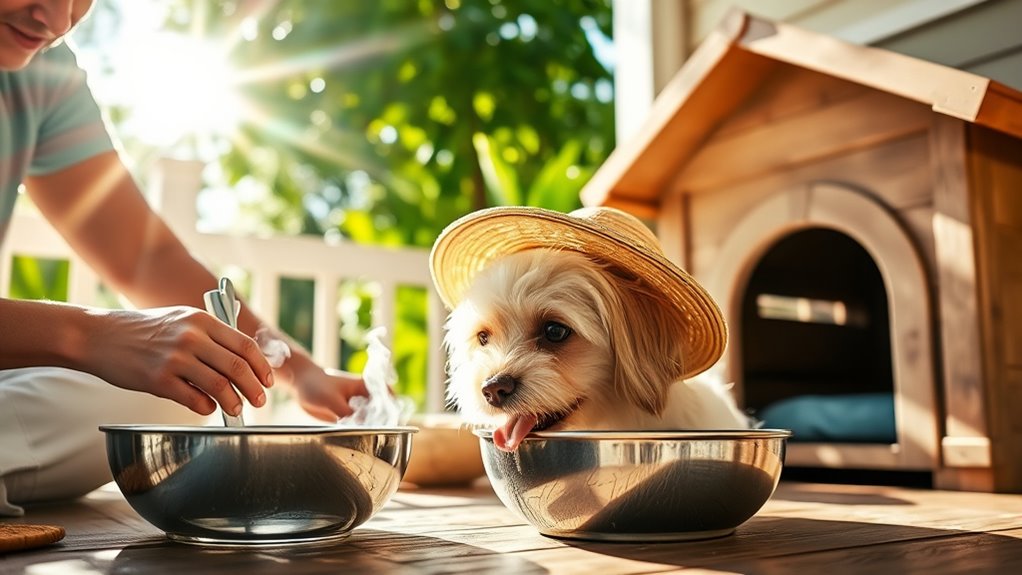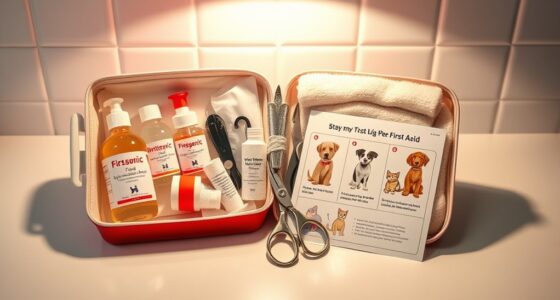To prepare your pets for extreme heat, make certain they have access to fresh, clean water at all times and add ice cubes to keep it cool. Provide shaded shelters outdoors and keep indoor areas cooled with fans or air conditioning. Walk them during cooler parts of the day, and avoid outdoor activity during peak heat. Watch for signs of heat stress, and if you want to learn effective ways to protect your pets, keep exploring these helpful tips.
Key Takeaways
- Ensure pets have access to fresh, clean water at all times, adding ice cubes to keep it cool.
- Provide shaded outdoor shelters and cool indoor environments with fans or air conditioning.
- Avoid outdoor walks during peak heat; opt for early mornings or evenings to prevent overheating.
- Use cooling mats, damp cloths, or misting to help lower your pet’s body temperature.
- Watch for signs of heat stress and seek veterinary care immediately if symptoms appear.

As temperatures soar, it is essential to take proactive steps to protect your pets from the dangers of extreme heat. Ensuring they stay cool and hydrated isn’t just about comfort—it’s about preventing heatstroke, dehydration, and other heat-related illnesses. One of the most effective ways to do this is by implementing pet cooling methods and following fundamental summer safety tips. These measures not only keep your furry friends safe but also give you peace of mind during the hottest days of the year.
Start with hydration. Always provide your pets with access to fresh, clean water, especially if they’re outside or active. Consider adding ice cubes to their water bowls to keep the water cool longer and encourage them to drink more. Dehydration can happen quickly in the heat, so keep an eye on your pets’ water intake and ensure they’re drinking enough throughout the day. If you notice signs of dehydration—such as dry gums, lethargy, or sunken eyes—you need to act fast and seek veterinary care. Remember, some pets, especially those with thick coats or senior animals, are more prone to dehydration and heat stress, so monitor them carefully. Additionally, understanding contrast ratio in your pet’s environment can help you optimize cooling strategies and create a safer space for them.
In addition to hydration, pet cooling methods are essential. Provide shaded areas where your pets can escape direct sunlight. If you’re outdoors, set up a shaded shelter or use a canopy to block the sun’s rays. For indoor spaces, keep the environment cool by using air conditioning or fans, and consider placing a damp cloth or cooling mat for your pet to lie on. Cooling mats are excellent summer safety tips because they offer a comfortable place for your pet to relax without overheating. You can also mist your pet lightly with water or use a damp towel to help lower their body temperature. Never leave your pet in a parked car, as temperatures inside can skyrocket within minutes, even with the windows cracked.
Be mindful of your pet’s activity level during the hottest parts of the day. Early mornings and evenings are better times for walks and play. When you do go outside, stick to grassy areas rather than pavement, which can burn their paws and reflect heat. Keep walks short, and always carry water for your pet to drink. Watch for signs of heat exhaustion, such as excessive panting, drooling, weakness, or vomiting. If you notice these symptoms, move your pet to a cooler place immediately and contact your vet.
Frequently Asked Questions
How Can I Tell if My Pet Is Overheating?
You can tell if your pet is overheating by watching for signs like excessive panting, drooling, or weakness. Check if their paw cooling feels unusually hot or if they’re lethargic, which may indicate heat exhaustion. If your pet shows these symptoms, move them to a cooler area immediately, offer water, and prevent further paw heating. Prompt action helps prevent heatstroke and keeps your pet safe during extreme heat.
Are Certain Breeds More Vulnerable to Heat?
You might notice that certain breeds are more vulnerable to heat, especially those with breed susceptibility like brachycephalic dogs or thick-coated breeds. These breeds generally have lower heat tolerance, making them prone to overheating faster. While all pets need protection in hot weather, pay extra attention to these breeds, providing shade and cool, fresh water. Recognizing breed differences helps you prevent heat-related illnesses and keeps your pet safe.
What Signs Indicate Dehydration in Pets?
You can tell your pet’s dehydrated if they show signs of dehydration like dry gums, excessive panting, lethargy, or sunken eyes. Pet hydration cues also include a decreased skin elasticity and dark-colored urine. Keep an eye on these symptoms, especially during hot weather, and make sure they have constant access to fresh water. If you notice any of these signs, boost their hydration immediately and consult your vet if necessary.
How Often Should I Give My Pet Water During Heatwaves?
During heatwaves, you should give your pet fresh water at least every 1-2 hours to maintain proper water intake. Keep hydration tips in mind, like offering water frequently even if they’re not thirsty and ensuring their water bowl is always clean. If your pet shows signs of dehydration, increase water frequency and consider providing wet food or ice cubes for extra hydration. Never let your pet go without water in extreme heat.
Can Outdoor Shelters Protect Pets From Extreme Heat?
Outdoor shelters can be your pet’s cool oasis, but they aren’t magic shields against heat. Well-designed outdoor shelter with ample shade provision and ventilation acts like a refuge from the blazing sun. Guarantee it’s built with reflective materials and positioned in a shaded area, allowing your pet to escape the scorching rays. Proper outdoor shelter design helps keep your pet safe, but always supplement with fresh water and plenty of shade.
Conclusion
Now that you know how to keep your pets safe during extreme heat, it’s time to take action. Make certain they stay hydrated, provide shady shelter, and avoid the hottest parts of the day. Remember, a prepared pet owner is worth their weight in gold—don’t wait until it’s too late. By staying proactive, you can prevent heat-related emergencies and keep your furry friends happy and healthy all summer long. Stay vigilant and look out for their well-being!










